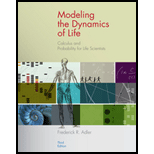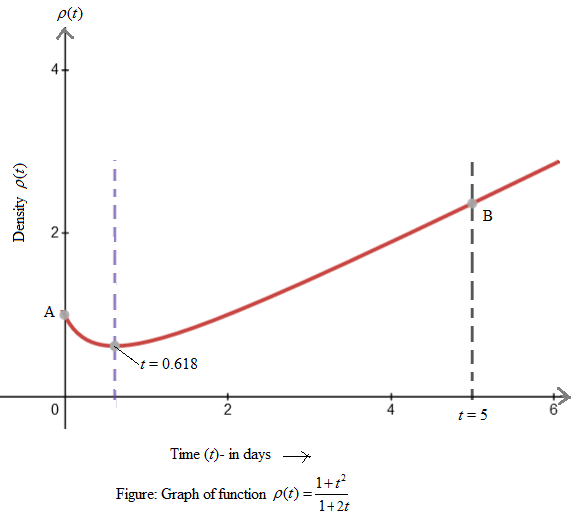
a.
To find:The mass density of the material of an insect as a function of time.
a.
Answer to Problem 36E
The density of the material of insect as the function of time is
Explanation of Solution
Given: The given mass function
Concept Used:
The mass M of an object is related to volume V of the object according to relation
Calculation:
The mass and volume of the insect are functions time given as
Therefore, the density of the material the insect is made of is also time dependent given by
Conclusion:
The density of the material of insect as the function of time is
b.
To find:The derivative of the density
b.
Answer to Problem 36E
The derivative of density
Explanation of Solution
Given:
The expression for density is
Formula used:
The derivative of function
Calculation:
The density isthe function of t given by
Now, the derivative of
Conclusion:
The derivative of density
c.
To find: At what time the density
c.
Answer to Problem 36E
The density will increase when
Explanation of Solution
Given:
The derivative density computed in part (a) as a function of time is
Concept used:
A function
Calculation:
The derivative of density is
The density will increase when
Conclusion:
The density will increase when
d.
To graph:The density given in part (a) for first 5 days.
d.
Explanation of Solution
Given:
The density function computed in part (a)
Concept used:
We use graphing calculator for the graph.
Graph:
The graph of the function

Interpretation:
We see clearly that the function
Want to see more full solutions like this?
Chapter 2 Solutions
Modeling the Dynamics of Life: Calculus and Probability for Life Scientists
- Explain the difference between the average rate of change of y as x changes a to b, and the instantaneous rate of change of y at x=aarrow_forwardUse the total differential to approximate each quantity. Then use a calculator to approximate the quantity, and give the absolute value of the differences in the two results to 4decimal places. (1.922+2.12)13arrow_forwardUse the table of values you made in part 4 of the example to find the limiting value of the average rate of change in velocity.arrow_forward
 Calculus For The Life SciencesCalculusISBN:9780321964038Author:GREENWELL, Raymond N., RITCHEY, Nathan P., Lial, Margaret L.Publisher:Pearson Addison Wesley,
Calculus For The Life SciencesCalculusISBN:9780321964038Author:GREENWELL, Raymond N., RITCHEY, Nathan P., Lial, Margaret L.Publisher:Pearson Addison Wesley, Functions and Change: A Modeling Approach to Coll...AlgebraISBN:9781337111348Author:Bruce Crauder, Benny Evans, Alan NoellPublisher:Cengage Learning
Functions and Change: A Modeling Approach to Coll...AlgebraISBN:9781337111348Author:Bruce Crauder, Benny Evans, Alan NoellPublisher:Cengage Learning
 College AlgebraAlgebraISBN:9781305115545Author:James Stewart, Lothar Redlin, Saleem WatsonPublisher:Cengage Learning
College AlgebraAlgebraISBN:9781305115545Author:James Stewart, Lothar Redlin, Saleem WatsonPublisher:Cengage Learning




